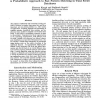Free Online Productivity Tools
i2Speak
i2Symbol
i2OCR
iTex2Img
iWeb2Print
iWeb2Shot
i2Type
iPdf2Split
iPdf2Merge
i2Bopomofo
i2Arabic
i2Style
i2Image
i2PDF
iLatex2Rtf
Sci2ools
KDD
1997
ACM
1997
ACM
A Probabilistic Approach to Fast Pattern Matching in Time Series Databases
Theproblemof efficiently and accurately locating patterns of interest in massivetimeseries data sets is an important and non-trivial problemin a wide variety of applications, including diagnosis and monitoringof complexsystems, biomedicMdata analysis, and exploratory data analysis in scientific and businesstime series. In this paper a probabflistic approachis taken to this problem.Usingpiecewise linear segmentations as the underlyingrepresentation, local features (such as peaks, troughs, and plateaus) are defined using prior distribution on expecteddeformationsfroma basic template. Global shapeinformation is represented using another prior on the relative locations of the individual features. Anappropriately defined probabilistic modelintegrates the local and global informationand directly leads to an overall distance measure betweensequencepatterns based on prior knowledge. Asearch algorithm using this distance measure is shownto efficiently and accurately find matchesfor a variety o...
Related Content
| Added | 08 Aug 2010 |
| Updated | 08 Aug 2010 |
| Type | Conference |
| Year | 1997 |
| Where | KDD |
| Authors | Eamonn J. Keogh, Padhraic Smyth |
Comments (0)

